Lol I say that because it's kind of ironic that we are arguing about AUDIO EQUIPMENT and we use an accepted method of measuring certain audio gear but bash the same method for other audio gear. My argument is if these measurements have nothing to do with what a human can actually hear why are we using this method at all?Sure. If you're going for top of the line, sota performance (and many of us do) then detailed measurements are hands down the best metric. You mentioned "hear a difference" tho, and I'm wondering if it's true that anyone can. I'm just sayin', there is a method to test for it...
-
WANTED: Happy members who like to discuss audio and other topics related to our interest. Desire to learn and share knowledge of science required. There are many reviews of audio hardware and expert members to help answer your questions. Click here to have your audio equipment measured for free!
You are using an out of date browser. It may not display this or other websites correctly.
You should upgrade or use an alternative browser.
You should upgrade or use an alternative browser.
RCA cables make no difference, that's what they say
- Thread starter pma
- Start date
Pogre
Active Member
- Joined
- Mar 5, 2022
- Messages
- 209
- Likes
- 257
Well I'm not bashing measurements. I do think they're valuable, and the most accurate way to objectively judge performance. Beyond a certain limit tho, it comes down to splitting inaudible hairs and folks get caught up chasing after sota performance whether it's audible or not. Me too. I think it's just the way we're wired. Likely some pride in ownership. I'm sure there's some interesting psychology behind it, but I do get it.Lol I say that because it's kind of ironic that we are arguing about AUDIO EQUIPMENT and we use an accepted method of measuring certain audio gear but bash the same method for other audio gear. My argument is if these measurements have nothing to do with what a human can actually hear why are we using this method at all?
I don't turn my nose up at measuring or the process at all and want to have the best performance my money can buy like everyone else. I'm not gonna be crushed if I find out something I own has a li'l more inaudible distortion than another piece with even lower inaudible distortion tho, and in this particular case with the cables the differences seem pretty negligible.
Last edited:
We are the same then lolWell I'm not bashing measurements. I do think they're valuable, and the most accurate way to objectively judge performance. Beyond a certain limit tho, it comes down to splitting inaudible hairs and folks get caught up chasing after sota performance whether it's audible or not. Me too. I think it's just the way we're wired. Likely some pride in ownership. I'm sure there's some interesting psychology behind it, but I do get it.
I don't turn my nose up at measuring or the process at all and want to have the best performance my money can buy like everyone else. I'm not gonna be crushed if I find out something I own has a li'l more inaudible distortion than another piece with even lower audible distortion tho, and in this particular case with the cables the differences seem pretty negligible.
- Thread Starter
- #64
I'm not seeing anything here approaching real world audibility, even accounting for power amp gain (from your first DVD interconnect, there would be roughly -80dBV at the speakers, translating to about 20 dBSPL at one meter from an extremely sensitive horn, in a frequency range where hearing is not very sensitive).
I have asked for closure of my thread

Can you hear a difference between audio cables? ABX test
Following the thread https://www.audiosciencereview.com/forum/index.php?threads/stereophile-and-audio-cables.53011/ I have prepared a listening test with 2 different audio cables. The cables are as dissimilar as they can be. The test files can be downloaded from https://pmacura.cz/cable1-2.zip...
 www.audiosciencereview.com
www.audiosciencereview.com
because the topic there was the ABX test and the topic has been completely covered and further discussion only diluted the goal of the thread.
However, the current thread is oriented to measured examples from the beginning, so I will try to explain what is my point, purely technical and engineering point.
@SIY , you seem to be a smart man and as such you know that the measurement shown in the post #1 covered only one specific example. The issue with single ended signal loop is, however, general. For those who are not so well oriented in the circuit analysis, I have prepared a detailed drawing with explanation. The latest ABX test configuration was this:
The DAC (DacMagicPlus) was interconnected with the ADC (E1DA Cosmos ADC) via the RCA cable, which has a live signal wire (black) and signal return wire (red). The signal return wire ("ground", shield) is connected through the ADC PCB ground to USB2 cable ground, this goes to PC, there it is internally connected to USB1 cable ground, and through DAC PCB ground again to RCA cable shield/ground return wire. This path as described constitutes a ground loop with several sources of noise voltages - both USB cables with digital transfer (impulses) of which the USB2 serves also as a DC supply and a potential capacitive leak through the DAC supply adapter. As a result, we get the error current Ig flowing through the signal ground loop, which contains both individual interfering frequencies as well as noise like modulation. This Ig error current inevitably creates error voltage Ve across the RCA cable shield (signal return) and this error voltage is added to the useful audio signal as a noise modulated floor + spike frequencies. How big is the Ve is defined by RCA cable shield impedance Zc, which has both resistive and inductive components. In this described arrangement I have made measurements with several RCA cables of various lengths and constructions and I will post it again as they are necessary for understanding the issue.
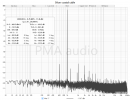
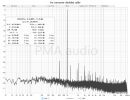

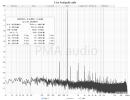
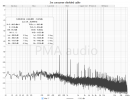
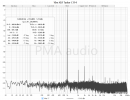
As a comparison, 10m balanced line was added as well to show that the balanced line fixes the problem completely.
One may oppose that I am showing a specific case. Yes, a specific case, but not the impossible case. In fact, multichannel systems or systems with active speakers are often much more complex and many of them do not have balanced line inputs/outputs to make a cure. Several ASR members have complained about the troubles that are exactly described in this post.
As can be seen, the S/N has been worsened of about 30dB with the worst cable, falling to 71.1dB. It has become audible and detectable in the ABX test, 16/16 result was posted in the thread linked above.
Finally, I do not need to be advised that the issue may be fixed also by the USB isolator. I know, I can do it and I do it. But not everyone is aware of it and not everyone is able to analyze the situation. The issue is of course system related, but is not rare.
Last edited:
And yet, the vast majority of the time, it works without incident. Yes, balanced is more noise immune, this is pretty basic knowledge. But at line level, you have to work pretty hard to make a standard single ended system pick up significant noise.* Even yours all looked well under -100dB (I still am waiting for an answer on what that weird ARTA spectrum was). If I read you correctly, you did exactly what I would have done to spot the noise by ear- turn the volume way up in a quiet passage. That's not exactly a reasonable use case.The issue with single ended signal loop is, however, general.
I run one of my systems balanced, the other unbalanced. They're both dead silent. I can induce a little bit of noise in the single ended system by using some Morrow interconnects that don't have a shield, so there's that (though this is radiative rather than circulating current). With cheapie RCA/coaxial wire using an aluminized polyester shield, silence returns. My phono system is balanced, but that's where the real benefits come.
*I exclude non-home use like long studio runs or stadiums.
Have you run a audio cable sound quality test using a 5G cel tel and a network router separately and in tandem to induce RF noise into the single ended audio cable(s)? This seems to be a upcoming thing and @KSTR thinks that is a issue that we are not incorporating into the ASR mantra or into the entire audio industry. In the 1990s we where experiencing the brick and bag sized high power cel tels inducing RF energy into CD players and causing audio sound quality issues. I witnessed it occurring. People where selecting CD players on their ability to reject RF energy. @amirm this could be a excellent basis for a test review if you can use your Samsung Galaxy 5G cel tel with a high power router to test the idea and look for audible sound quality distortion as well as meter this with your test equipment.I run one of my systems balanced, the other unbalanced. They're both dead silent. I can induce a little bit of noise in the single ended system by using some Morrow interconnects that don't have a shield, so there's that (though this is radiative rather than circulating current). With cheapie RCA/coaxial wire using an aluminized polyester shield, silence returns.
And yet, the vast majority of the time, it works without incident. Yes, balanced is more noise immune, this is pretty basic knowledge. But at line level, you have to work pretty hard to make a standard single ended system pick up significant noise.* Even yours all looked well under -100dB (I still am waiting for an answer on what that weird ARTA spectrum was). If I read you correctly, you did exactly what I would have done to spot the noise by ear- turn the volume way up in a quiet passage. That's not exactly a reasonable use case.
I run one of my systems balanced, the other unbalanced. They're both dead silent. I can induce a little bit of noise in the single ended system by using some Morrow interconnects that don't have a shield, so there's that (though this is radiative rather than circulating current). With cheapie RCA/coaxial wire using an aluminized polyester shield, silence returns. My phono system is balanced, but that's where the real benefits come.
*I exclude non-home use like long studio runs or stadiums.
Tunnel-visioning for a purely black and white qualitative statement without considering the quantitative context is a nonsensical argument really.
When I'm on my cell phone, I can't hear the system noise.Have you run a audio cable sound quality test using a 5G cel tel and a network router separately and in tandem to induce RF noise into the single ended audio cable(s)?
There's a repeater about a meter away from my single ended system. No ill effects at that frequency and power, at least. I have some pretty good audio test gear but no microwave stuff handy at my house, and TBH, I've not felt motivated to pack up my test gear and take it over to the EE labs at school.
I'm very protective of my test gear when I have a operational calibrated lab and I too avoid carrying it from place to place. I'm excited to see if @amirm will take on this test project.and TBH, I've not felt motivated to pack up my test gear and take it over to the EE labs at school.
When I'm on my cell phone, I can't hear the system noise.
There's a repeater about a meter away from my single ended system. No ill effects at that frequency and power, at least. I have some pretty good audio test gear but no microwave stuff handy at my house, and TBH, I've not felt motivated to pack up my test gear and take it over to the EE labs at school.
I did heard interference coming from a adjacent multi-port USB charger presumably with poor EMI filtering, but it took me a loooooong time to found out and only did when I literally put my ear right next to the iLoud tweeter. It's a very faint random pulsing noise instead of the usual white noise hiss.
Disappeared after replacing that with a new Ugreen GAN 100W.
Similar threads
- Replies
- 6
- Views
- 701
- Replies
- 8
- Views
- 561
- Replies
- 18
- Views
- 2K
- Replies
- 21
- Views
- 7K
